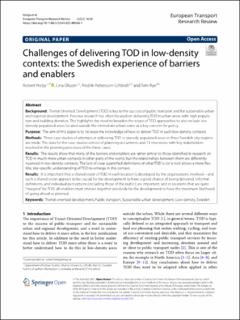| dc.contributor.author | Hrelja, Robert | |
| dc.contributor.author | Olsson, Lina | |
| dc.contributor.author | Pettersson-Löfstedt, Fredrik | |
| dc.contributor.author | Rye, Tom | |
| dc.date.accessioned | 2024-04-23T11:49:59Z | |
| dc.date.available | 2024-04-23T11:49:59Z | |
| dc.date.created | 2022-05-23T12:42:02Z | |
| dc.date.issued | 2022 | |
| dc.identifier.citation | European Transport Research Review. 2022, 14 (1), 1-11. | en_US |
| dc.identifier.issn | 1867-0717 | |
| dc.identifier.uri | https://hdl.handle.net/11250/3127784 | |
| dc.description.abstract | Background: Transit Oriented Development (TOD) is key to the success of public transport and for sustainable urban and regional development. Previous research has often focused on delivering TOD in urban areas with high popula‑ tion and building densities. This highlights the need to broaden the scope of TOD approaches to also include less densely populated areas located outside the immediate urban cores as a key concern for policy. Purpose: The aim of this paper is to increase the knowledge of how to deliver TOD in such low-density contexts. Methods: Three case studies of attempts at delivering TOD in sparsely populated areas in three Swedish city-regions are made. The data for the case studies consist of planning documents and 13 interviews with key stakeholders involved in the planning processes of the three cases. Results: The results show that many of the barriers and enablers are rather similar to those identifed in research on TOD in much more urban contexts in other parts of the world, but the relationships between them are diferently nuanced in low-density contexts. The lack of clear quantifed defnitions of what TOD is (or is not) allows a more fex‑ ible, site-specifc understanding of TOD to emerge in this context. Results: It is important that a shared vision of TOD in each location is developed by the organizations involved—and such a shared vision appears to be crucial for the development to have a good chance of being delivered. Informal defnitions, and individual perceptions (including those of the public) are important; and in locations that are quite “marginal” for TOD, all enablers must interact together positively for the development to have the maximum likelihood of going ahead as planned. Keywords: transit-oriented development, public transport, sustainable urban development, low-density, Sweden | en_US |
| dc.language.iso | eng | en_US |
| dc.relation.uri | https://doi.org/10.1186/s12544-022-00546-1 | |
| dc.rights | Navngivelse 4.0 Internasjonal | * |
| dc.rights.uri | http://creativecommons.org/licenses/by/4.0/deed.no | * |
| dc.title | Challenges of delivering TOD in low-density contexts : the Swedish experience of barriers and enablers | en_US |
| dc.type | Peer reviewed | en_US |
| dc.type | Journal article | en_US |
| dc.description.version | publishedVersion | en_US |
| dc.source.pagenumber | 1-11 | en_US |
| dc.source.volume | 14 | en_US |
| dc.source.journal | European Transport Research Review | en_US |
| dc.source.issue | 1 | en_US |
| dc.identifier.doi | 10.1186/s12544-022-00546-1 | |
| dc.identifier.cristin | 2026492 | |
| cristin.ispublished | true | |
| cristin.fulltext | original | |
| cristin.qualitycode | 1 | |

